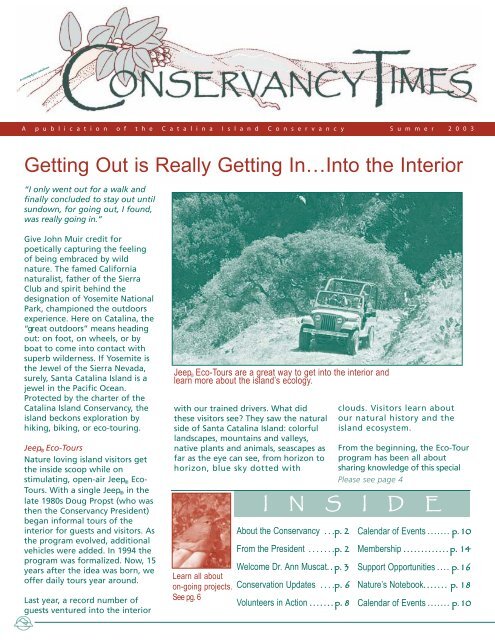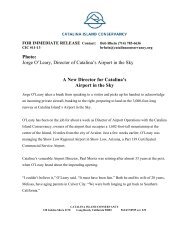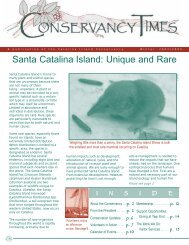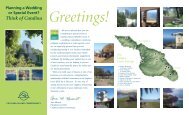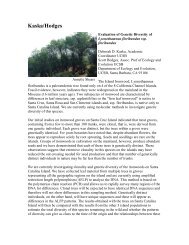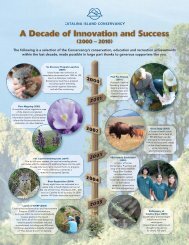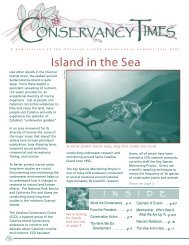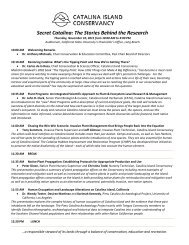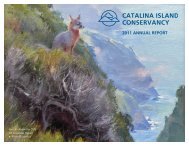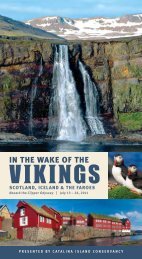Getting Out is Really Getting Inâ¦Into the Interior - Catalina Island ...
Getting Out is Really Getting Inâ¦Into the Interior - Catalina Island ...
Getting Out is Really Getting Inâ¦Into the Interior - Catalina Island ...
Create successful ePaper yourself
Turn your PDF publications into a flip-book with our unique Google optimized e-Paper software.
Arctostaphylos catalinae<br />
A p u b l i c a t i o n o f t h e C a t a l i n a I s l a n d C o n s e r v a n c y S u m m e r 2 0 0 3<br />
<strong>Getting</strong> <strong>Out</strong> <strong>is</strong> <strong>Really</strong> <strong>Getting</strong> In…Into <strong>the</strong> <strong>Interior</strong><br />
“I only went out for a walk and<br />
finally concluded to stay out until<br />
sundown, for going out, I found,<br />
was really going in.”<br />
Give John Muir credit for<br />
poetically capturing <strong>the</strong> feeling<br />
of being embraced by wild<br />
nature. The famed California<br />
natural<strong>is</strong>t, fa<strong>the</strong>r of <strong>the</strong> Sierra<br />
Club and spirit behind <strong>the</strong><br />
designation of Yosemite National<br />
Park, championed <strong>the</strong> outdoors<br />
experience. Here on <strong>Catalina</strong>, <strong>the</strong><br />
“great outdoors” means heading<br />
out: on foot, on wheels, or by<br />
boat to come into contact with<br />
superb wilderness. If Yosemite <strong>is</strong><br />
<strong>the</strong> Jewel of <strong>the</strong> Sierra Nevada,<br />
surely, Santa <strong>Catalina</strong> <strong>Island</strong> <strong>is</strong> a<br />
jewel in <strong>the</strong> Pacific Ocean.<br />
Protected by <strong>the</strong> charter of <strong>the</strong><br />
<strong>Catalina</strong> <strong>Island</strong> Conservancy, <strong>the</strong><br />
<strong>is</strong>land beckons exploration by<br />
hiking, biking, or eco-touring.<br />
Jeep ® Eco-Tours<br />
Nature loving <strong>is</strong>land v<strong>is</strong>itors get<br />
<strong>the</strong> inside scoop while on<br />
stimulating, open-air Jeep ® Eco-<br />
Tours. With a single Jeep ® in <strong>the</strong><br />
late 1980s Doug Propst (who was<br />
<strong>the</strong>n <strong>the</strong> Conservancy President)<br />
began informal tours of <strong>the</strong><br />
interior for guests and v<strong>is</strong>itors. As<br />
<strong>the</strong> program evolved, additional<br />
vehicles were added. In 1994 <strong>the</strong><br />
program was formalized. Now, 15<br />
years after <strong>the</strong> idea was born, we<br />
offer daily tours year around.<br />
Last year, a record number of<br />
guests ventured into <strong>the</strong> interior<br />
Jeep ® Eco-Tours are a great way to get into <strong>the</strong> interior and<br />
learn more about <strong>the</strong> <strong>is</strong>land’s ecology.<br />
with our trained drivers. What did<br />
<strong>the</strong>se v<strong>is</strong>itors see? They saw <strong>the</strong> natural<br />
side of Santa <strong>Catalina</strong> <strong>Island</strong>: colorful<br />
landscapes, mountains and valleys,<br />
native plants and animals, seascapes as<br />
far as <strong>the</strong> eye can see, from horizon to<br />
horizon, blue sky dotted with<br />
Learn all about<br />
on-going projects.<br />
See pg. 6<br />
clouds. V<strong>is</strong>itors learn about<br />
our natural h<strong>is</strong>tory and <strong>the</strong><br />
<strong>is</strong>land ecosystem.<br />
From <strong>the</strong> beginning, <strong>the</strong> Eco-Tour<br />
program has been all about<br />
sharing knowledge of th<strong>is</strong> special<br />
I N S I D E<br />
About <strong>the</strong> Conservancy . . .p. 2<br />
rom <strong>the</strong> President . . . . . . .p. 2<br />
Welcome Dr. Ann Muscat..p. 3<br />
Conservation Updates . . . .p. 6<br />
Volunteers in Action .......p. 8<br />
Please see page 4<br />
Calendar of Events ....... p. 10<br />
Membership .............p. 14<br />
Support Opportunities .... p. 16<br />
Nature’s Notebook....... p. 18<br />
Calendar of Events ....... p. 10
C ATALINA I SLAND CONSERVANCY<br />
B E N E F A C T O R M E M B E R S<br />
Robert Given, Chair<br />
James H. Ackerman<br />
Paxson H. Offield<br />
Al<strong>is</strong>on Wrigley Rusack<br />
B O A R D O F D I R E C T O R S<br />
Maria Pellegrini, Chair<br />
Geoffrey Rusack, Vice Chair<br />
Norr<strong>is</strong> J. B<strong>is</strong>hton, Jr.<br />
Clifford Hague<br />
Richard Harp<br />
Charles Hathaway<br />
Marie Knowles<br />
Robert Me<strong>is</strong>trell<br />
Anthony Michaels<br />
Ann M. Muscat<br />
Calvin Parsons<br />
Ada Blanche Schreiner<br />
D i r e c t o r s E m e r i t u s<br />
A. Douglas Propst Robert Thorne<br />
E L E C T E D O F F I C E R S<br />
Ann M. Muscat,<br />
President/Chief Executive Officer<br />
J. Scott Wauben,<br />
Treasurer/Chief inancial Officer<br />
Bruce Guay,<br />
Corporate Secretary<br />
D E P A R T M E N T<br />
Lenny Al<strong>the</strong>rr<br />
Steve Dawes<br />
David Gardner<br />
Rebecca Guay<br />
Mark Hoefs<br />
Deb Jensen<br />
Kathleen King<br />
Paul Moritz<br />
Jane Pulsinelli<br />
Peter Schuyler<br />
Charles Wright<br />
M A N A G E R S<br />
Director,acilities Management<br />
Superv<strong>is</strong>or, Special Projects<br />
Director, Security<br />
Director, V<strong>is</strong>itor Services<br />
Director & Curator,<br />
Wrigley Botanical Garden<br />
Director, Education<br />
Director, Volunteer Services<br />
Director, Airport Operations<br />
Ass<strong>is</strong>tant Treasurer<br />
Director, Ecological Restoration<br />
Director, Development<br />
rom <strong>the</strong> President<br />
Dear Friends,<br />
Since <strong>the</strong> forming of <strong>the</strong> Conservancy, one of<br />
<strong>the</strong> mandates for <strong>the</strong> organization has been<br />
to allow for appropriate recreational use of<br />
<strong>the</strong> <strong>is</strong>land. Over <strong>the</strong> past thirty years, many<br />
thousands of people have enjoyed hiking,<br />
camping, bicycling, and touring <strong>the</strong> interior.<br />
<strong>Catalina</strong> <strong>is</strong> an amazing destination for nature<br />
lovers and wilderness adventurers!<br />
Th<strong>is</strong> summer, we begin implementation of our<br />
Trail Plan. Trails offer a low impact way for<br />
recreational users to access remote wilderness<br />
areas of <strong>the</strong> <strong>is</strong>land. Well designed trails at popular locations channel<br />
footsteps appropriately, allowing for ecological protection and restoration<br />
of sensitive areas.<br />
Besides safety and conservation, <strong>the</strong> educational and recreational<br />
possibilities of well-designed trails include d<strong>is</strong>covery of interesting<br />
h<strong>is</strong>torical sites, beautiful v<strong>is</strong>tas, experiencing <strong>the</strong> diverse terrain and<br />
natural habitats on <strong>the</strong> <strong>is</strong>land, and exerc<strong>is</strong>ing mind, body and spirit. It <strong>is</strong><br />
exciting to look forward to all aspects of such an important endeavor!<br />
You will be hearing more about th<strong>is</strong> project throughout <strong>the</strong> year.<br />
Ano<strong>the</strong>r significant project about to be launched <strong>is</strong> <strong>the</strong> improvement of<br />
access to Ben Weston Beach. Since 1995, when <strong>the</strong> old road to <strong>the</strong> beach<br />
washed out, we have been deliberating <strong>the</strong> best and most feasible way to<br />
attend to <strong>the</strong> situation. In April, <strong>the</strong> Conservancy’s Board of Directors<br />
voted to go forward with building a new road, providing that <strong>the</strong><br />
appropriate permits and adequate funding are procured. A map and<br />
more details about <strong>the</strong> Ben Weston Road project are available by calling<br />
Bruce Guay at 310-510-2595, ext. 106.<br />
The scope of <strong>the</strong> Conservancy continues to expand was we endeavor to<br />
remain true to <strong>the</strong> original intent of <strong>the</strong> organization. I am honored to<br />
have been a part of th<strong>is</strong> important work for <strong>the</strong> past 29 years. It <strong>is</strong> with a<br />
mixture of melancholy, confidence, and excitement that I am changing<br />
roles. Dr. Ann Muscat assumes <strong>the</strong> title and responsibilities of President<br />
and CEO effective July 1, 2003. I will continue on as a consultant to <strong>the</strong><br />
organization for <strong>the</strong> next few months. My husband, David, and I will<br />
continue to live in Avalon and, of course, will always be among <strong>the</strong><br />
<strong>Catalina</strong> <strong>Island</strong> Conservancy’s most fervent supporters.<br />
Sincerely,<br />
Contact Us<br />
(310) 510 - 2595<br />
editor@catalinaconservancy.org<br />
or v<strong>is</strong>it us at<br />
125 Claressa Avenue Avalon, CA<br />
V<strong>is</strong>itor Services hours 8:30 a.m. - 5 p.m. daily<br />
From <strong>the</strong> Editor: You may notice that several articles in th<strong>is</strong> <strong>is</strong>sue use scientific<br />
names as well as common names for <strong>is</strong>land plants and animals. Common names<br />
can be confusing because often a plant or animal has various common names,<br />
and sometimes different-but-similar organ<strong>is</strong>ms are called by <strong>the</strong> same common<br />
name. We want to be very clear about <strong>the</strong> species mentioned for those readers<br />
who are interested. So, <strong>the</strong> common names are l<strong>is</strong>ted first, in regular font, and<br />
<strong>the</strong> scientific or Latin names follow, in paren<strong>the</strong>ses, with text in italic.<br />
2<br />
<strong>Catalina</strong> <strong>Island</strong> Conservancy
Welcome Dr. Ann M. Muscat<br />
New President and CEO<br />
The Board of Directors of <strong>the</strong> Santa <strong>Catalina</strong> <strong>Island</strong> Conservancy has selected Dr. Ann M. Muscat, former Santa<br />
<strong>Catalina</strong> <strong>Island</strong> resident, as its next President and Chief Executive Officer, effective July 1, 2003. Dr. Muscat lived on<br />
Santa <strong>Catalina</strong> <strong>Island</strong> for eight years, conducting marine research and serving as Director of <strong>the</strong> University of<br />
Sou<strong>the</strong>rn California’s Wrigley Marine Science Center at Big F<strong>is</strong>herman Cove. She <strong>is</strong> an avid sailor and diver, and has<br />
been coming to <strong>the</strong> <strong>is</strong>land and enjoying its natural beauty for more than 24 years.<br />
“Ann brings a wealth of talent, skills and knowledge to <strong>the</strong> Conservancy. Her time living on <strong>Catalina</strong> and her love of<br />
<strong>the</strong> <strong>Island</strong>, combined with her experience in leadership positions in nonprofit organizations make her <strong>the</strong> ideal<br />
choice for th<strong>is</strong> position,” said Board Chair, Dr. Maria Pellegrini.<br />
Muscat received her doctorate in biological sciences from <strong>the</strong> University of Sou<strong>the</strong>rn California working in <strong>the</strong><br />
near-shore marine environment of Santa <strong>Catalina</strong> <strong>Island</strong>. While Director of <strong>the</strong> Wrigley Marine Science Center she<br />
establ<strong>is</strong>hed <strong>the</strong> Marine Life Refuge that protects <strong>the</strong> waters immediately surrounding <strong>the</strong> laboratory from<br />
harvesting and anchoring pressures. She also initiated <strong>the</strong> popular Elderhostel Program, which has been<br />
introducing interested adults to <strong>the</strong> ecology of Santa <strong>Catalina</strong> <strong>Island</strong> for more than 15 years.<br />
“I am excited and pleased to be returning to Santa <strong>Catalina</strong> <strong>Island</strong> at <strong>the</strong> helm of such an important organization,”<br />
said Muscat. “The Santa <strong>Catalina</strong> <strong>Island</strong> Conservancy and <strong>Catalina</strong> can serve as a model for balancing human<br />
uses with nature’s needs, and inspire people to enjoy, understand and become responsible stewards of <strong>the</strong>ir<br />
natural world.”<br />
After completing her work with <strong>the</strong> Marine Science Center, Muscat served as Deputy Director and Senior Vice<br />
President for Exhibits and Education at <strong>the</strong> California Science Center in Los Angeles. There she played a pivotal<br />
role in <strong>the</strong> transformation and rebuilding of that public institution. As part of <strong>the</strong> master plan for <strong>the</strong> California<br />
Science Center, she directed <strong>the</strong> development of <strong>the</strong> conceptual program and design for a science elementary<br />
school now being built in partnership with <strong>the</strong> Los Angeles<br />
Unified School D<strong>is</strong>trict.<br />
Muscat also served as <strong>the</strong> Executive Vice President for<br />
Strategic Initiatives at <strong>the</strong> Natural H<strong>is</strong>tory Museum of Los<br />
Angeles County. There, she led <strong>the</strong> Board of Trustees and<br />
staff through a strategic v<strong>is</strong>ioning process that redefined<br />
<strong>the</strong> role of a natural and cultural h<strong>is</strong>tory museum in <strong>the</strong><br />
21st century. Muscat also directed <strong>the</strong> completion of <strong>the</strong><br />
preliminary architectural and exhibition studies for a major<br />
rebuilding of <strong>the</strong> Natural H<strong>is</strong>tory Museum’s infrastructure.<br />
She has worked throughout her career to promote sciencebased<br />
conservation and environmental education. She has<br />
been invited to lecture in China and India on her ecological<br />
and museological work, and she was a Research Associate<br />
in <strong>the</strong> United States Antarctic Program.<br />
Muscat received her master’s degree in biology from San<br />
Diego State University and her bachelor’s in biology from<br />
<strong>the</strong> University of Detroit.<br />
Conservancy Times<br />
3
<strong>Island</strong> Recreation<br />
continued from page 1<br />
Our new Sunset tour combines <strong>the</strong> interior tour with a<br />
stop for a view of <strong>the</strong> sunset. Included are drinks and<br />
a selection of hors d'oeuvres, cheese, fruit and crackers.<br />
We have a great group of driver guides for <strong>the</strong> season<br />
including: Julien Foreman, Fred Freeman, Chuck Holt,<br />
Steve Pillman, Don Van Sickle, Beth Vandervelde and<br />
Jim Watson.<br />
Jeep ® Eco-Tours create revenue to support Conservancy<br />
programs while at <strong>the</strong> same time bringing v<strong>is</strong>itors to<br />
<strong>the</strong> interior to enjoy and learn about our wonderful<br />
<strong>is</strong>land. Don’t m<strong>is</strong>s a great adventure. Support <strong>the</strong><br />
Conservancy and join us for a tour. Reservations<br />
can be made by calling <strong>the</strong> Conservancy office<br />
at (310) 510-2595 ext. 0.<br />
Eco-Tour staff (l to r) Dave Gaon, Jim Watson, Don Van<br />
Sickel, Steve Pillman, Beth Vandervelde and Fred Freeman.<br />
place. Our unique tours of <strong>Catalina</strong> journey off <strong>the</strong><br />
primary roads, onto rugged four wheel drive lanes. We<br />
have access to over 100 miles of roads, most of which are<br />
not open to <strong>the</strong> public. Our drivers are natural<strong>is</strong>t-qualified<br />
having completed substantial classroom and field training.<br />
Trip itineraries vary depending on passenger interest, road<br />
conditions and time of year. Drivers are <strong>is</strong>land residents<br />
and have wide-ranging familiarity of <strong>the</strong> interior.<br />
Our tours are true ecology trips with emphas<strong>is</strong><br />
on <strong>the</strong> <strong>is</strong>land’s living beings and <strong>the</strong>ir<br />
relationship to one ano<strong>the</strong>r and to <strong>the</strong>ir<br />
physical environment. No o<strong>the</strong>r tour begins to<br />
present <strong>the</strong> experience of a Jeep ® Eco-Tour on<br />
Santa <strong>Catalina</strong> <strong>Island</strong>. Often, but not always,<br />
bald eagles, reptiles, and <strong>the</strong> elusive <strong>Catalina</strong><br />
<strong>Island</strong> Fox are seen. The interior has so much to<br />
offer, including wonderful v<strong>is</strong>tas and <strong>the</strong> quiet<br />
serenity of nature.<br />
On Foot<br />
Hiking enthusiasts d<strong>is</strong>cover that <strong>Catalina</strong> <strong>is</strong> complex.<br />
First off, you notice <strong>the</strong> widely varied natural<br />
communities. For instance, Ben Weston beach <strong>is</strong> as<br />
wild and remote as any beach on <strong>the</strong> West Coast. In<br />
Cottonwood Canyon, a forest habitat rich with wildlife<br />
thrives under <strong>the</strong> dense, leafy canopy of native oaks.<br />
There are grasslands on <strong>the</strong> <strong>is</strong>land, too. Above Ripper’s<br />
Cove (one of <strong>the</strong> <strong>is</strong>land’s boat-in beach campgrounds),<br />
California bunch grasses add texture to hillsides<br />
generously sprinkled with wildflowers from February<br />
Several routes enable repeat v<strong>is</strong>itors to enjoy<br />
different areas at different times of <strong>the</strong> year.<br />
Our half and full day charters are mapped out<br />
with <strong>the</strong> guests to accommodate <strong>the</strong>ir<br />
requests. We are proud to show off and talk<br />
about <strong>the</strong> wonders of Santa <strong>Catalina</strong> <strong>Island</strong>.<br />
There are two new tours for 2003. On <strong>the</strong> 3 ½<br />
hour <strong>Catalina</strong> by Land and Sea tour, we have<br />
combined our most popular tour of <strong>the</strong> interior with<br />
a tour by boat. Our guests travel one way by boat or<br />
Jeep ® to Whites Landing for lunch at <strong>the</strong> beach and<br />
return to Avalon. There are many ways to enjoy<br />
Santa <strong>Catalina</strong> <strong>Island</strong>! <strong>Catalina</strong> by Land and Sea <strong>is</strong> <strong>the</strong><br />
perfect introduction.<br />
<strong>Getting</strong> out for a hike offers many rewards.<br />
until June. Deep gorges echo birdsongs. On <strong>the</strong> West<br />
End, landslides of slippery silvery sch<strong>is</strong>t and raw red<br />
erosion gullies are reminders of on-going geologic<br />
changes. And <strong>the</strong>n <strong>the</strong>re are <strong>the</strong> views! The<br />
unpredictable hues of sky and ocean contrast with <strong>the</strong><br />
dramatic silhouettes of a steeply sloped landscape.<br />
Most often, <strong>the</strong> sky <strong>is</strong> a dazzling blue and <strong>the</strong><br />
Mediterranean climate <strong>is</strong> mild and appealing. But<br />
4<br />
<strong>Catalina</strong> <strong>Island</strong> Conservancy
<strong>Island</strong> Recreation<br />
sometimes, chilly fog swirls<br />
around <strong>the</strong> shoulders of<br />
<strong>the</strong> hills, <strong>the</strong> wind whips,<br />
and waves pun<strong>is</strong>h <strong>the</strong><br />
shore. On <strong>the</strong> o<strong>the</strong>r hand,<br />
summertime temperatures<br />
in <strong>Catalina</strong>’s low-growing<br />
coastal sage scrub and<br />
chaparral communities can<br />
scorch. Hat, sunscreen, and<br />
plenty of drinking water<br />
are primary gear. There are<br />
only a few locations for<br />
refilling water bottles, so<br />
bring plenty.<br />
Hikers must reg<strong>is</strong>ter for a<br />
permit at <strong>the</strong> Conservancy<br />
House in Avalon, at <strong>the</strong><br />
Airport-in-<strong>the</strong>-Sky, or at<br />
Two Harbors V<strong>is</strong>itor<br />
Services. The permit <strong>is</strong> free<br />
and required. Please see <strong>the</strong><br />
calendar section of th<strong>is</strong> newsletter for guided hike<br />
information.<br />
Bicycl<strong>is</strong>ts<br />
The <strong>Catalina</strong> <strong>Island</strong> Conservancy <strong>is</strong> pleased to offer a<br />
bicycle program for <strong>the</strong> serious cycl<strong>is</strong>t who wants to<br />
enjoy <strong>the</strong> natural beauty and tranquility of Santa<br />
<strong>Catalina</strong> <strong>Island</strong>. Permits are required at a fee of $50 for<br />
an individual and $75 for a family (spouse and minor<br />
children). Permits are valid from <strong>the</strong> date of purchase<br />
until <strong>the</strong> following April 30th and prorated quarterly<br />
beginning May 1st. Included in <strong>the</strong> permit fee <strong>is</strong><br />
coverage for accident, liability, and life insurance while<br />
riding on <strong>Catalina</strong>.<br />
Due to <strong>the</strong> <strong>is</strong>land's rugged interior, mountain bikes are<br />
required and riders must wear helmets that meet <strong>the</strong><br />
safety standards set by ei<strong>the</strong>r <strong>the</strong> American National<br />
Standards Institute (ANSI) or Snell Memorial Foundation.<br />
A limited number of roads are open to bicycling and for<br />
<strong>the</strong> most part are improved gravel.<br />
Bicycle permits may be obtained at <strong>the</strong> Conservancy<br />
Office, 125 Claressa, 8:30 AM - 5 PM daily (closed for<br />
lunch Saturday and Sunday). Permits are also available<br />
Touring by mountain bike <strong>is</strong> both challenging and rewarding.<br />
at <strong>Catalina</strong>'s Airport-in-<strong>the</strong>-<br />
Sky and Two Harbors V<strong>is</strong>itor<br />
Services during <strong>the</strong>ir regular<br />
hours of operation. Bicycle<br />
permits are not available by<br />
mail or telephone, <strong>the</strong>y must<br />
be purchased in person at <strong>the</strong><br />
locations mentioned above.<br />
Nearly a million people v<strong>is</strong>it<br />
Santa <strong>Catalina</strong> <strong>Island</strong> each<br />
year. Of those, thousands<br />
pass through <strong>the</strong> Conservancy<br />
House for information about<br />
access to <strong>the</strong> interior. These<br />
v<strong>is</strong>itors are special because<br />
<strong>the</strong>y are looking for an<br />
experience not found in<br />
Avalon, but an adventure<br />
into a natural environment,<br />
seventy-six square miles of<br />
undeveloped wilderness.<br />
At Conservancy House, V<strong>is</strong>itor Services Representatives<br />
Liz Johnson and Diane Conover are at <strong>the</strong> ready to<br />
greet <strong>the</strong>se folks, answer questions, hand out brochures<br />
and <strong>is</strong>sue <strong>the</strong> permits that will take <strong>the</strong>m into th<strong>is</strong><br />
special place.<br />
No matter what your mode of transportation, getting<br />
out <strong>is</strong> <strong>the</strong> key to finding <strong>the</strong> very best of <strong>Catalina</strong>. Be<br />
prepared, <strong>the</strong> <strong>is</strong>land <strong>is</strong> capricious; every day out <strong>is</strong> a<br />
fresh experience. It's best to expect <strong>the</strong> unexpected.<br />
Rebecca Guay, Director of V<strong>is</strong>itor Services<br />
Deb Jensen, Director of Education<br />
Dave Gaon, Jeep ® Eco-Tour Superv<strong>is</strong>or<br />
Each year an average of 6,772 hikers, 1,580 runners, and 850<br />
bicycl<strong>is</strong>ts recreate on Conservancy property, while 1,417 people<br />
participate in our Jeep ® Eco-Tour Program. We <strong>is</strong>sue 650 annual<br />
vehicle permits, 370 daily vehicle permits, and 28 moped<br />
permits as well.<br />
Thank You For Your Contribution<br />
The <strong>Catalina</strong> <strong>Island</strong> Conservancy’s Admin<strong>is</strong>tration and Accounting Departments thank volunteers for ass<strong>is</strong>ting with general office,<br />
special events, VIP driving and much more. Your time <strong>is</strong> appreciated. James H. Ackerman, Lenny Al<strong>the</strong>rr, Linda Al<strong>the</strong>rr, Norr<strong>is</strong> B<strong>is</strong>hton, Jr., Joel Burt, Lynn<br />
Burt, Caitlin Dawes, Steve Dawes, Chr<strong>is</strong>ta Foster, David Gaon, Dave Gardner, Rose Ellen Gardner, Bob Given, Rebecca Guay, Cliff Hague, Rick Harp, Charles Hathaway,<br />
Mar<strong>is</strong>ella Hernandez, Liz Johnson, Kathleen King , Marie Knowles, Robert Me<strong>is</strong>trell, Anthony Michaels, Ian Mor<strong>is</strong>on, Robert Mor<strong>is</strong>on, Richard Murphy, Hank O’Melveny,<br />
Paxson Offield, Calvin Parsons, Maria Pellegrini, Al<strong>is</strong>on Rusack, Geoffrey Rusack, Linda Salo, Ron Salo, Ada Blanche Schreiner, Eric Schwartz, Esmeralda Soto, M<strong>is</strong>dee Wrigley.<br />
Conservancy Times<br />
5
Conservation Updates<br />
Counting Marine Mammals Along<br />
<strong>Catalina</strong>’s Coastline<br />
May 14 th was a cool, cloudy morning and <strong>the</strong> mostly calm seas<br />
reg<strong>is</strong>tered a chilly 60 degrees, but th<strong>is</strong> did not deter numerous<br />
California Sea Lions (Zalophus californianus) from frolicking about<br />
in <strong>the</strong> waters of Avalon Harbor, along Pebbly Beach and on past<br />
<strong>the</strong> quarry. As we approached Seal Rocks, it became obvious that it<br />
was going to be an amazing day to view marine mammals. Using<br />
binoculars, we counted at least 117 sea lions hauled out on <strong>the</strong><br />
rocks and beaches of <strong>the</strong> Seal Rocks area. Several more could be<br />
seen darting back and forth amongst a pod of Common Bottlenose<br />
Dolphins (Tursiops tuncatus) traveling through <strong>the</strong> nearby waters.<br />
<strong>Catalina</strong>’s ecosystems are not only essential for terrestrial plants and animals, but also for marine mammals,<br />
such as seals and sea lions, which use <strong>the</strong> <strong>is</strong>land’s numerous beaches and offshore rocks to haul out for<br />
important activities such as molting and pupping.<br />
Each spring and fall, Conservancy biolog<strong>is</strong>ts conduct a census of <strong>the</strong> marine mammals that use <strong>the</strong> <strong>is</strong>land’s<br />
various beaches and offshore rocks. The census records <strong>the</strong> number and type of marine mammals in order to<br />
monitor how <strong>the</strong>ir populations fluctuate through time. Th<strong>is</strong> spring’s count was our fifth and largest census<br />
ever. With <strong>the</strong> help of volunteer Captain Scott Wauben and h<strong>is</strong> boat Dulcinea, we began our clockw<strong>is</strong>e<br />
circumnavigation of <strong>the</strong> <strong>is</strong>land at around 7 AM.<br />
As we proceeded around <strong>the</strong> far East End of <strong>the</strong> <strong>is</strong>land and just west of Binnacle Rock, we came across our first<br />
sighting of Harbor Seals (Phoca vitulina), a group of 35, including a few young pups, hauled out on <strong>the</strong> beach<br />
and not <strong>the</strong> least bit interested in our position 200-300 feet offshore. Continuing westward we came across<br />
even larger congregations of Harbor Seals hauled out on <strong>the</strong> beaches between China Point and Ben Weston,<br />
with several groups numbering more than 50 individuals. Then at Land’s End, we observed ano<strong>the</strong>r large<br />
assemblage of sea lions, 35 th<strong>is</strong> time, lounging on some offshore rocks.<br />
The surf had become increasingly choppy as we rounded Land’s End and we were all ready for a change of<br />
pace as <strong>the</strong> waves began to flatten out and our peaceful journey resumed once more on <strong>the</strong> Channel side of<br />
<strong>the</strong> <strong>is</strong>land. As we traveled past <strong>the</strong> coves and Isthmus, we continued to record seal and sea lion sightings both<br />
in <strong>the</strong> water and hauled out on rocks and beaches along <strong>the</strong> way. However, a wonderful surpr<strong>is</strong>e still awaited<br />
us on a beach near Frog Rock. There we observed a female Nor<strong>the</strong>rn Elephant Seal (Mirounga angustirostr<strong>is</strong>), a<br />
new marine mammal for our species l<strong>is</strong>t, hauling out of <strong>the</strong> water. It was approximately 2 PM when we pulled<br />
back into Avalon Harbor and our census was concluded.<br />
Overall, 565 pinnipeds were observed that day, 285 seals (two species) and 280 sea lions, making it our largest<br />
count ever. The fact that pinniped numbers were three times greater than those for past spring counts suggest<br />
that prey items, such as squid and anchovy, may have been extremely plentiful in <strong>Catalina</strong>’s waters at <strong>the</strong> time<br />
of <strong>the</strong> census, perhaps attracting seals and sea lions from o<strong>the</strong>r areas to <strong>the</strong> <strong>is</strong>land.<br />
Angela Aarhus<br />
Field Biolog<strong>is</strong>t<br />
Helping Hands<br />
The Facilities Management Department gives a heartfelt thank you to <strong>the</strong> following volunteers for all of<br />
<strong>the</strong>ir efforts: NCCC Western Region Americorps, Jani E<strong>is</strong>enhut, Fred Freeman, David Larsen, Tracy Larsen, Paul McIlroy, Calvin<br />
Parsons, Richard Pelouze, Bruce Seibert, and Chr<strong>is</strong> Messett U.C.L.A.<br />
6<br />
<strong>Catalina</strong> <strong>Island</strong> Conservancy
Conservation<br />
Learning More About<br />
Orange-crowned Warblers<br />
The Orange-crowned Warbler (Vermivora celata)<br />
breeds widely over western and nor<strong>the</strong>rn North<br />
America, and east across Canada. There are four<br />
recognized subspecies of th<strong>is</strong> warbler. One of <strong>the</strong>m,<br />
<strong>the</strong> sordida subspecies (Vermivora celata<br />
ssp.sordida), <strong>is</strong> endemic to <strong>the</strong> Channel <strong>Island</strong>s and<br />
reaches its highest density on Santa <strong>Catalina</strong> <strong>Island</strong>.<br />
Th<strong>is</strong> subspecies <strong>is</strong> fairly different from o<strong>the</strong>rs that<br />
breed on <strong>the</strong> continent, however, its life h<strong>is</strong>tory <strong>is</strong><br />
poorly known. While mainland Orange-crowned<br />
Warblers are long d<strong>is</strong>tance migrants and strict<br />
ground nesters, <strong>the</strong> sordidas are year round<br />
residents on <strong>the</strong> <strong>is</strong>lands or migrate a very short<br />
d<strong>is</strong>tance to <strong>the</strong> coast of Sou<strong>the</strong>rn California and nest<br />
in shrubs or trees as well as on <strong>the</strong> ground.<br />
In March 2003, researchers from <strong>the</strong> Smithsonian<br />
Migratory Bird Center and <strong>the</strong> University of<br />
California at Riverside began a long-term study on<br />
Santa <strong>Catalina</strong> <strong>Island</strong> to better understand <strong>the</strong> life<br />
h<strong>is</strong>tory and ecology of th<strong>is</strong> warbler. One hundred<br />
individuals including males, females and nestlings<br />
were captured and banded. Th<strong>is</strong> banded population<br />
will allow determination of which proportion of <strong>the</strong><br />
population stays year round or leaves <strong>the</strong> <strong>is</strong>land<br />
during <strong>the</strong> fall.<br />
Over 90 nests are being monitored. On <strong>the</strong> <strong>is</strong>land,<br />
<strong>the</strong>se warblers start breeding in early March and<br />
nest mainly in shrubs (Lemonade Berry, Coyote<br />
Brush, Monkey Flower), although several nests were<br />
found on <strong>the</strong> ground as well as in trees (<strong>Island</strong> Scrub<br />
Oak) at 3 or 4 meters high. A very interesting<br />
finding <strong>is</strong> that <strong>the</strong> <strong>is</strong>land sordida warblers are<br />
double brooders, in contrast with <strong>the</strong> mainland<br />
Orange-crowned Warblers that have only one brood<br />
a year. Orange-crowned Warblers feed by gleaning<br />
insects from plant leaves. During March <strong>the</strong> warblers<br />
forage mainly on oaks and in late April and May<br />
<strong>the</strong>y also get many insects from <strong>the</strong> grass and nectar<br />
from flowers.<br />
We are approaching <strong>the</strong> end of <strong>the</strong> breeding season<br />
for <strong>the</strong> sordida Orange-crowned Warblers and <strong>the</strong><br />
field <strong>is</strong> loaded with newborn fledglings. So, hurry<br />
up, get your binoculars and try to find <strong>the</strong>m! If you<br />
are lucky you will get to see <strong>the</strong>ir puffed orange<br />
crown.<br />
Note: If you encounter any banded bird try to get<br />
<strong>the</strong> color combination on its legs and please let us<br />
know when and where you saw it. You can email<br />
<strong>the</strong> researchers at susanaip@ucr.edu.<br />
Susana Peluc<br />
Researcher<br />
U.C. Riverside<br />
The Status of B<strong>is</strong>on on <strong>the</strong> <strong>Island</strong><br />
Maintaining a<br />
herd size of 150 -<br />
200 animals, a<br />
change in <strong>the</strong><br />
time of shipping<br />
extra animals, and<br />
a request for<br />
more study on <strong>the</strong><br />
interaction of<br />
b<strong>is</strong>on and nonnative<br />
annual<br />
grasses were<br />
among <strong>the</strong> new<br />
b<strong>is</strong>on management guidelines adopted by <strong>the</strong> Board of<br />
Directors of <strong>the</strong> Santa <strong>Catalina</strong> <strong>Island</strong> Conservancy at its<br />
April meeting. After reviewing <strong>the</strong> results of a two year<br />
study documenting <strong>the</strong> ecological impacts of b<strong>is</strong>on on<br />
<strong>Catalina</strong>’s natural resources, <strong>the</strong> Board was able to<br />
make an informed dec<strong>is</strong>ion based on sound scientific<br />
findings. The study was conducted by independent<br />
outside researchers from <strong>the</strong> University of North<br />
Dakota and <strong>the</strong> University of California at Dav<strong>is</strong>. The<br />
final report was received in January 2003, and <strong>the</strong><br />
Conservancy Board of Directors and staff gave it careful<br />
review before <strong>the</strong> management dec<strong>is</strong>ions were made.<br />
The report, Population Ecology and Ecological Effects<br />
of B<strong>is</strong>on on Santa <strong>Catalina</strong> <strong>Island</strong>, <strong>is</strong> available to <strong>the</strong><br />
public at Conservancy offices, <strong>the</strong> public library, and on<br />
<strong>the</strong> Internet. A recap of <strong>the</strong> management strategy <strong>is</strong> as<br />
follows:<br />
v Herd size will be maintained between 150 to 200 animals.<br />
v B<strong>is</strong>on will continue to be allowed range between<br />
<strong>the</strong> fence at Two Harbors and <strong>the</strong> fence at <strong>the</strong><br />
Summit. Health of <strong>the</strong> animals <strong>is</strong> important and will<br />
be monitored.<br />
v Fur<strong>the</strong>r research will be conducted to explore <strong>the</strong><br />
relationship between b<strong>is</strong>on and non-native annual<br />
grasses on <strong>the</strong> <strong>is</strong>land, especially as related to <strong>the</strong><br />
potential of wildland fire, and <strong>the</strong> spread of nonnative<br />
grasses.<br />
v The Conservancy will seek <strong>the</strong> advice of expert<br />
range mangers to explore management options to<br />
fur<strong>the</strong>r reduce <strong>the</strong> impacts of b<strong>is</strong>on on <strong>the</strong> <strong>is</strong>land’s<br />
natural resources.<br />
v An annual roundup to maintain animal numbers at a<br />
target of 150 will be completed by August. Extra<br />
animals will be shipped to <strong>the</strong> mainland.<br />
Conservancy Times<br />
7
Volunteers in Action<br />
<strong>the</strong> front of <strong>the</strong> nursery, followed by sporty games of “King of<br />
<strong>the</strong> Mulch Hill” played atop a nine-foot pile of eucalyptus<br />
mulch. We also worked at Airport in <strong>the</strong> Sky doing some<br />
maintenance work on <strong>the</strong> grounds of <strong>the</strong> Nature Center. The<br />
highlight of our day was a buffet style lunch of sandwiches and<br />
brownies provided by <strong>the</strong> Conservancy Education<br />
Department.<br />
On our last day, <strong>the</strong> group ventured into Avalon to explore <strong>the</strong><br />
town and take a break from work. Our activities included<br />
kayaking, snorkeling, v<strong>is</strong>iting <strong>the</strong> Botanical Gardens, shopping,<br />
and of course dining at <strong>the</strong> many restaurants in town. A change<br />
from <strong>the</strong> week’s camp foods like hot dogs and peanut butter<br />
and jelly sandwiches was much needed and enjoyed!<br />
8<br />
Spring Break, But Differently<br />
Spring Break! Relax on <strong>the</strong> beach, take a rest from hectic<br />
academic schedules! Or, for a group of students from <strong>the</strong><br />
University of Arizona (UofA), spring break <strong>is</strong> <strong>the</strong> opportunity to<br />
travel to new communities and participate in philanthropic<br />
activities. Th<strong>is</strong> group <strong>is</strong> called Alternative Breaks, and from<br />
March 14-22 students traveled to <strong>Catalina</strong> to volunteer with<br />
<strong>the</strong> <strong>Catalina</strong> <strong>Island</strong> Conservancy.<br />
Alternative Breaks <strong>is</strong> a non-profit, student run organization at<br />
<strong>the</strong> UofA in Tucson, Arizona. It <strong>is</strong> a local chapter of a nationwide<br />
program based out of Florida State University called, Break<br />
Away. Each year an average of 5 service-oriented trips are taken<br />
in surrounding areas to provide members meaningful spring<br />
break projects as an alternative to le<strong>is</strong>ure activities. Trips are<br />
funded by <strong>the</strong> participants, through fundra<strong>is</strong>ing events, grants,<br />
support of local businesses, and <strong>the</strong> University.<br />
Th<strong>is</strong> spring break, fourteen participants ranging from<br />
freshmen to seniors and including majors such as Veterinary<br />
and Wildlife Sciences, Finance, and Engineering, piled into two<br />
vans bound for Long Beach, CA. It was raining when we<br />
reached Long Beach, approximately 10 hours later. We took a<br />
ferry to Santa <strong>Catalina</strong> <strong>Island</strong> and were greeted by <strong>the</strong><br />
Conservancy’s Coordinator of Volunteers.<br />
During <strong>the</strong> week we camped at <strong>the</strong> Laura Stein Volunteer<br />
Camp, jokingly coined <strong>the</strong> “Hilton in <strong>the</strong> Hills.” We were amazed<br />
by <strong>the</strong> campground facility and at <strong>the</strong> fact that volunteers<br />
constructed a majority of it. The greater part of our free time in<br />
<strong>the</strong> evenings was spent huddled around <strong>the</strong> outdoor kitchen<br />
area preparing dinner, or sitting around <strong>the</strong> campfire telling<br />
stories and l<strong>is</strong>tening to NPR radio for updates on <strong>the</strong> war with<br />
Iraq.<br />
Throughout <strong>the</strong> week we worked with <strong>the</strong> Conservancy to<br />
complete landscaping work for <strong>the</strong> James H. Ackerman Native<br />
Plant Nursery. Landscaping included mulching and weeding<br />
We started <strong>the</strong> week at <strong>the</strong> UofA as a group of newly<br />
acquainted students, coming toge<strong>the</strong>r to work on a service<br />
project. We ended <strong>the</strong> week as a group of close friends who<br />
had just spent an amazing spring break toge<strong>the</strong>r on Santa<br />
<strong>Catalina</strong> <strong>Island</strong>. Our time with <strong>the</strong> <strong>Catalina</strong> <strong>Island</strong> Conservancy<br />
will be forever remembered by each of us, and our<br />
organization hopes to continue a relationship with<br />
Conservancy into <strong>the</strong> future.<br />
Jessica Stevens,<br />
Alternative Breaks Site Leader<br />
Wanted: Information Leading to<br />
Invasive Plant Control<br />
Sixty known invasive plant species on Santa <strong>Catalina</strong> <strong>Island</strong> are<br />
being exposed to scrutiny. The Conservancy and California<br />
State Polytechnic University at San Lu<strong>is</strong> Ob<strong>is</strong>po graduate<br />
student John Knapp are collecting data to develop a prioritized<br />
invasive plant management plan. Invasive plants in California<br />
are defined as species introduced after European contact<br />
through direct or indirect human activity. Invasive plants arrive<br />
and become naturalized 1,000 times faster by human activities<br />
than <strong>the</strong>y would under natural conditions; native plants and<br />
animals haven’t <strong>the</strong> time to deal with <strong>the</strong> invasion through<br />
evolution. Invasive plants d<strong>is</strong>place vegetation that provides<br />
habitat for wildlife, but <strong>the</strong>ir most severe impacts ar<strong>is</strong>e when<br />
<strong>the</strong>y alter ecosystem processes such as fire frequency, soil<br />
<strong>Catalina</strong> <strong>Island</strong> Conservancy
Volunteers<br />
erosion and chem<strong>is</strong>try, and water flow in streams. Invasive<br />
species like Dyer’s greenwold (Gen<strong>is</strong>ta linifolia), Italian th<strong>is</strong>tle<br />
(Carduus pycnocephalus) and tamar<strong>is</strong>k (Tamarix spp.) are<br />
among o<strong>the</strong>rs found on <strong>Catalina</strong> that create <strong>the</strong>se impacts.<br />
Controlling invasive plants without a management plan <strong>is</strong> like<br />
trying to win a baseball game without any batters; it doesn’t<br />
work, you must have a full-lineup strategy. By knowing <strong>the</strong><br />
character<strong>is</strong>tics and invasiveness of each species, we can<br />
determine how much of a threat each species truly poses to<br />
<strong>the</strong> health and stability of <strong>Catalina</strong>’s <strong>is</strong>land ecosystem. The<br />
plan will accompl<strong>is</strong>h th<strong>is</strong> goal through four stages: 1) Map<br />
each species, 2) Conduct a literature review of biological<br />
character<strong>is</strong>tics, such as flowering period, seed production and<br />
invasiveness of each species, 3) Model <strong>the</strong> climatic conditions<br />
of certain species’ area of origin to infer potential<br />
invasiveness, and <strong>the</strong>n 4) Subject all species to ranking for<br />
prioritization of control taking into consideration <strong>the</strong> <strong>is</strong>land<br />
habitat infested, size and density of each invasive population,<br />
ease of control, and level of invasiveness. Thus far volunteers<br />
have played an integral part in <strong>the</strong> mapping aspect, and<br />
without <strong>the</strong>ir knowledge and work, it would be an even<br />
greater challenge to survey <strong>the</strong> whole <strong>is</strong>land. Scheduled<br />
completion for <strong>the</strong> plan <strong>is</strong> March 2004.<br />
Santa <strong>Catalina</strong> <strong>Island</strong> <strong>is</strong> home to many plants and animals that<br />
are not found or enjoyed anywhere else on earth, and has<br />
some of <strong>the</strong> best natural habitat left in Sou<strong>the</strong>rn California. If<br />
we work now to protect it from invasive plants, we can keep it<br />
that way.<br />
Mapping <strong>the</strong> Invasive Plants<br />
On <strong>the</strong> weekend of March 22 -23, nine volunteers, one<br />
Conservancy employee, and one researcher traversed <strong>the</strong><br />
ridges and drainages of Middle Canyon to map invasive plants<br />
for <strong>the</strong> Second Invasive Plant Mapping Extravaganza.<br />
Imagine picking up a hitchhiker and taking him in to your<br />
home with <strong>the</strong> good intensions of helping someone out. Now<br />
imagine coming home after a long day’s work to only find<br />
him sprawled out on your couch taking up all <strong>the</strong> space,<br />
eating all your food, sleeping in your bed, and inviting h<strong>is</strong><br />
buddies over to share in h<strong>is</strong> newfound wealth. That <strong>is</strong><br />
basically what invasive plants do. Somehow, directly or<br />
indirectly, <strong>the</strong>y have been given a ride through human<br />
activity into wildland ecosystems, such as <strong>Catalina</strong>’s, only to<br />
outcompete native species for water, nutrients, space and<br />
o<strong>the</strong>r valuable resources. Invasive plants can alter ecosystem<br />
processes while d<strong>is</strong>placing native plant species that provide<br />
habitat for wildlife. Giant reed (Arundo donax), which<br />
originated from Sou<strong>the</strong>ast Asia and <strong>is</strong> a serious and costly<br />
problem in much of <strong>the</strong> South Coast area, can d<strong>is</strong>place<br />
streamside vegetation that provides <strong>the</strong> necessary structure<br />
for many nesting birds. It also has shallow roots, which can<br />
result in soil erosion and silt accumulation downstream.<br />
Fortunately, giant reed was not found in <strong>the</strong> areas searched.<br />
Currently <strong>the</strong> Conservancy <strong>is</strong> mapping roughly sixty species<br />
of plants that are known to be invasive throughout California<br />
and on <strong>the</strong> <strong>is</strong>land. Th<strong>is</strong> information will aid <strong>the</strong> Conservancy in<br />
understanding <strong>the</strong> d<strong>is</strong>tribution and infestation of each<br />
species. Once <strong>the</strong> <strong>is</strong>land has been mapped, <strong>the</strong> data collected<br />
will be used to rank which invasive plants are of <strong>the</strong> greatest<br />
threat to <strong>the</strong> health of <strong>the</strong> <strong>is</strong>land, and to help guide<br />
management action.<br />
New and returning volunteers with expert<strong>is</strong>e on Santa<br />
<strong>Catalina</strong> <strong>Island</strong>, plant identification and <strong>the</strong> use of global<br />
positioning system (GPS) units recorded invasive plant<br />
location, population size and density, reproductive condition<br />
and habitat infested for each of <strong>the</strong> weeds found. The<br />
Conservancy owns and manages 42,173 acres, and without<br />
<strong>the</strong> efforts of volunteers from <strong>the</strong> <strong>is</strong>land and mainland,<br />
mapping invasive plants would be a daunting challenge.<br />
Mainland volunteers camped at <strong>the</strong> Laura Stein Volunteer<br />
Camp, and were joined in <strong>the</strong> morning by <strong>is</strong>land volunteers<br />
and Conservancy staff. After a long day of searching for<br />
invasive plants through po<strong>is</strong>on oak and prickly pear cactus,<br />
<strong>the</strong>y indulged in an excellent meal prepared by Mary Story.<br />
Her delicious treats eradicated everyone’s invasive appetites,<br />
and prepared <strong>the</strong>m for ano<strong>the</strong>r day of mapping. Over dinner<br />
and <strong>the</strong> camp fire, volunteers told tales of “<strong>the</strong> one that got<br />
away”- referring to invasive plants, and <strong>the</strong> rare and unique<br />
<strong>is</strong>land vegetation that was encountered while mapping.<br />
It took <strong>the</strong> eleven mappers ten hours to map half of Middle<br />
Canyon, which would have taken one mapper roughly three<br />
days to complete. The Invasive Plant Mapping Extravaganza<br />
would not have been a success if it were not for <strong>the</strong><br />
knowledge, enthusiasm and sweat of <strong>the</strong> nine volunteers.<br />
Thank you!<br />
John Knapp<br />
Invasive Plant Researcher<br />
Conservancy Times<br />
9
C ALENDAR<br />
Your guide to getting<br />
EDUCATION OFFERINGS<br />
July 9, Evening Nature Program<br />
8:00 p.m. Join Dr. Peter Sharpe, Institute<br />
for Wildlife Studies, as he d<strong>is</strong>cusses <strong>the</strong><br />
reintroduction of <strong>the</strong> Bald Eagles.<br />
Wrigley Memorial and Botanical Garden.<br />
Aug. 2, The HIKE<br />
8:00 a.m. Check out <strong>the</strong> huge restoration project going on<br />
in Middle Canyon.<br />
Reservations must be made by July 26.<br />
Aug. 13, Evening Nature Program<br />
8:00 p.m. "<strong>Catalina</strong> Views" <strong>is</strong> <strong>the</strong> year's work from some<br />
<strong>is</strong>land photographers. Come see what developed.<br />
Wrigley Memorial and Botanical Garden.<br />
Sept. 6, The HIKE<br />
8:00 a.m. Travel to Starlight Beach on <strong>the</strong> West End. Th<strong>is</strong><br />
HIKE departs from Two Harbors.<br />
Reservations must be made by Aug. 30.<br />
Sept. 10, Evening Nature Program<br />
7:00 p.m. "Bats Roost Here." Join Angela Aarhus, Field<br />
Biolog<strong>is</strong>t as she introduces us to <strong>Catalina</strong>'s bats.<br />
Los Angeles County Interpretive Center.<br />
Oct. 4, The HIKE<br />
8:00 a.m. Join us as we walk on a trail of beauty from Black<br />
Jack to Middle Ranch.<br />
Reservations must be made by Sept. 27.<br />
Nov. 1, The HIKE<br />
8:00 a.m. V<strong>is</strong>it <strong>the</strong> rarest tree in North America, <strong>the</strong><br />
endangered <strong>Catalina</strong> Mahogany.<br />
Reservations must be made by Oct. 25.<br />
Want to join in on an education program? Contact <strong>the</strong> Education<br />
Department (310) 510-0954 or education@catalinaconservancy.org<br />
VOLUNTEER HAPPENINGS<br />
Volunteer Vacations<br />
Volunteer Vacations are an exciting<br />
change of pace from <strong>the</strong> usual vacation.<br />
Your experience will serve as an excellent<br />
opportunity to learn about <strong>the</strong> unique ecology of Santa<br />
<strong>Catalina</strong> <strong>Island</strong>, give back to <strong>the</strong> environment, and have<br />
some fun at <strong>the</strong> same time.<br />
Sept 8 - 12 Volunteer Vacation<br />
Sept 22 - 26 Volunteer Vacation<br />
Save Our Seeds to Begin New Life<br />
Learn <strong>the</strong> different types of seeds and how <strong>the</strong>y are<br />
propagated for new life. Give us a call, we will train you on <strong>the</strong><br />
various techniques needed for seed processing. Don't let <strong>the</strong><br />
Seed Seekers get ahead of us!<br />
<strong>Island</strong> Field Day with <strong>the</strong> Ecological Restoration Dept.<br />
Come join <strong>the</strong> Ecological Restoration Department staff for<br />
<strong>the</strong>ir monthly <strong>is</strong>land “ER” Field Day, <strong>the</strong> first Tuesday of each<br />
month. Projects vary month to month and run <strong>the</strong> gamut<br />
from fence removal to out planting to weed removal. Call us<br />
in advance to find out what’s scheduled for <strong>the</strong> next exciting<br />
field day.<br />
V<strong>is</strong>itor Services Greeter<br />
Join our V<strong>is</strong>itor Services Team and greet v<strong>is</strong>itors at <strong>the</strong><br />
Conservancy House. Volunteers work alongside staff, <strong>is</strong>suing<br />
hiking permits and sharing general information about<br />
<strong>Catalina</strong> <strong>Island</strong> and <strong>the</strong> <strong>Catalina</strong> <strong>Island</strong> Conservancy. One<br />
Saturday a month 9:00 am to 1:00 pm. Training will be<br />
provided.<br />
GPS Mapping Opportunity<br />
Participate in a hands-on, field class to learn how to use our<br />
Trimble Explorer GPS units. Then travel around <strong>the</strong> <strong>is</strong>land<br />
mapping utility poles or non-native tree species in <strong>the</strong><br />
Middle Canyon watershed area. Volunteers should enjoy<br />
hiking and be able to hike over rigorous terrain. Vehicle and<br />
training are provided. Let us know your schedule.<br />
Would you like more information about <strong>the</strong>se and o<strong>the</strong>r volunteer<br />
opportunitites with <strong>the</strong> <strong>Catalina</strong> <strong>Island</strong> Conservancy? Call Director of<br />
Volunteer Services Kathy King at (310) 510-2595, ext. 102 or email<br />
volunteers@catalinaconservancy.org<br />
Please Don’t Overlook <strong>the</strong> Contribution Envelop<br />
Enclosed in th<strong>is</strong> <strong>is</strong>sue of <strong>the</strong> Conservancy Times <strong>is</strong> a contribution envelope. Whe<strong>the</strong>r or not you are currently a donor to <strong>the</strong> Conserva<br />
Your contributions allow us to do our work. And as we work our way through <strong>the</strong>se summer and upcoming fall months, our plannin<br />
makes it all possible. A contribution at th<strong>is</strong> time, in <strong>the</strong> enclosed return envelope, will help us.<br />
10<br />
<strong>Catalina</strong> <strong>Island</strong> Conservancy
Featuring .<br />
involved<br />
on <strong>Catalina</strong><br />
SUMMER NATURALIST<br />
PROGRAMS<br />
JUNE 28th THROUGH<br />
AUGUST 31ST<br />
Sundays, Avalon Nature Hike<br />
9 a.m. Come join us as we take a moderate uphill climb to<br />
<strong>the</strong> back of Avalon Canyon for spectacular views. Wrigley<br />
Memorial and Botanical Garden.<br />
Tuesdays, Avalon Nature Walk<br />
10 a.m. Enjoy a le<strong>is</strong>urely stroll through <strong>the</strong> gardens led by<br />
our knowledgeable natural<strong>is</strong>t guide.<br />
Wrigley Memorial and Botanical Garden.<br />
Learn to use <strong>the</strong> Trimble GPS to help with<br />
mapping projects on <strong>the</strong> <strong>Island</strong>.<br />
Fridays, Avalon Campfire Program<br />
8 p.m. Ga<strong>the</strong>r around for stories, legends and facts about<br />
<strong>Catalina</strong>’s h<strong>is</strong>tory at <strong>the</strong> evening campfire.<br />
Hermit Gulch Campground.<br />
Saturdays, Avalon Nature Walk<br />
10 a.m. Enjoy a guided le<strong>is</strong>urely stroll through <strong>the</strong><br />
botanical gardens led by our knowledgeable natural<strong>is</strong>t.<br />
Wrigley Memorial and Botanical Garden.<br />
Saturdays, Two Harbors Nature Walk<br />
10 a.m. Explore <strong>the</strong> natural h<strong>is</strong>tory of Two Harbors as we<br />
take a le<strong>is</strong>urely stroll at <strong>the</strong> Isthmus.<br />
Meet at <strong>the</strong> Conservancy Kiosk.<br />
Saturdays, Little Harbor Nature Walk<br />
3 p.m. Join us as we take a closer look at one of <strong>Catalina</strong>’s<br />
sensitive ecological areas.<br />
Meet at Little Harbor Campground kiosk.<br />
Enjoy a photo presentation by local<br />
photographers at “<strong>Catalina</strong> Views” on<br />
August 13 at <strong>the</strong> Wrigley Botanical Garden.<br />
Summer Natural<strong>is</strong>t Programs are FREE and open to <strong>the</strong> public<br />
(adm<strong>is</strong>sion for <strong>the</strong> Wrigley Memorial and Botanical Garden <strong>is</strong> $3.00<br />
for adults). Reservations are not required. For more information<br />
call 310-510-2595, ext. 134.<br />
e in Th<strong>is</strong> Issue<br />
ncy, please consider sending a contribution now.<br />
g and our projects increase and your financial contribution<br />
Join in on a hike or nature walk at one of<br />
our Summer Natural<strong>is</strong>t Programs through<br />
August 31st.<br />
Conservancy Times
Volunteers<br />
Volunteers Are Recognized in Style<br />
High energy was <strong>the</strong> mind-set at <strong>the</strong> Riviera Room on <strong>the</strong><br />
evening of April 3rd as <strong>the</strong> 11th annual Volunteer Reception<br />
kicked into full swing. A combination of volunteers, staff, Board<br />
of Directors, Benefactors and <strong>the</strong>ir guests totaling 170, filled <strong>the</strong><br />
room with laughter, goodwill and heartfelt appreciation<br />
for one ano<strong>the</strong>r. The Reception brings everyone toge<strong>the</strong>r<br />
for a fun time and also recognizes <strong>the</strong> achievements and<br />
milestones that many volunteers have accompl<strong>is</strong>hed.<br />
The year 2002 was indeed a year to be proud of for<br />
volunteers. A grand total of 21,020 hours was dedicated<br />
to various projects. To l<strong>is</strong>t a few:<br />
Eagles Nest Road Const.,Fox Habitat Const./Maint., Fence<br />
Removal, Trail Work, Seed Seekers, Brush Clearance,<br />
Reserve-Ranger, Exhibit planning, Field Trip Ass<strong>is</strong>tance,<br />
Environmental Education, B<strong>is</strong>on Research, Road Repair,<br />
Special Events, Chr<strong>is</strong>tmas Bird<br />
Count, Fence Walkers Plant<br />
Studies, VIP Dinners, Camp<br />
Maintenance, General<br />
Maintenance, Boat Captain,<br />
Burn Area Surveys, Data Entry,<br />
Drivers, Feral Cat Research,<br />
Seed Processing, Weed<br />
Removal, Weed Mapping,<br />
Land Bird Monitoring, Beach<br />
Cleanup, <strong>Out</strong>planting, Plant<br />
Propagation, Hike Leading,<br />
and Research.<br />
We were fortunate to work with<br />
47 Junior Volunteers who dedicated 1,248 hours<br />
in 2002. Each year <strong>the</strong> <strong>Catalina</strong> <strong>Island</strong><br />
Conservancy awards <strong>the</strong> Junior Volunteer with<br />
<strong>the</strong> most volunteer hours with a $50.00 savings<br />
bond. Th<strong>is</strong> year’s proud recipient was Robert<br />
Mor<strong>is</strong>on with a grand total of 54.5 hours. Robert,<br />
who <strong>is</strong> 12, has cons<strong>is</strong>tently volunteered since<br />
1996.<br />
Junior volunteers are an important part of<br />
<strong>the</strong> volunteer force.<br />
Milestones were many for 2002. Milestone<br />
awards for total accumulated hours are<br />
recognized at 100, 500, 1,000, and 2,000<br />
The Montgomery family celebrates<br />
increments. Receiving <strong>the</strong>ir one hundred hour Ryan’s accompl<strong>is</strong>hments.<br />
ruby lapel pins were Randy Boelsoms, Erica<br />
Browne, Joel and Lynn Burt, John Celick, Michael Clifford, William<br />
Corey, Joseph and Rita Dlugokecki, Annerose and Hans<br />
Grellmann, Richard Hague, Liz Johnson, Erick Katzmaier, Pat<br />
Klingensmith, Frank Minuto, Calvin Parsons, and Rudy Piltch. Five<br />
hundred hour emerald lapel pins were awarded to Cliff Hague,<br />
Ryan Montgomery and Roy Rose. One thousand hour diamond<br />
lapel pins went to Dean Hill and Ryan Montgomery. And<br />
receiving <strong>the</strong> 2,000-hour recognition award were Paul McIlroy<br />
and Steve Story. New for th<strong>is</strong><br />
year, <strong>the</strong> 2,000-hour award <strong>is</strong><br />
<strong>the</strong> “Wall of Honor.”<br />
Exhibited at V<strong>is</strong>itor Services<br />
in <strong>the</strong> Conservancy House,<br />
th<strong>is</strong> handsome oak wall<br />
proudly d<strong>is</strong>plays <strong>the</strong> names<br />
of volunteers who have<br />
reached th<strong>is</strong> colossal<br />
milestone.<br />
Steve and Mary Story, volunteers<br />
Additional awards were<br />
extraordinaire!<br />
received by a group of 14<br />
volunteers who dedicated a<br />
combined total of 4,543 hours of volunteer service.<br />
Ranging from 200 hours to 828 hours each, <strong>the</strong>se volunteers<br />
spent meaningful and rewarding time participating in many,<br />
many different jobs. Congratulations to Ryan Montgomery,<br />
Steve Story, Paul McIlroy, Mary Story, Dean Hill, Michael<br />
Clifford, Patricia Moore, Cliff Hague, Denn<strong>is</strong> McDonald,<br />
Whitey Mendenhall, Joel Burt, Lynn Burt, Shawn Cyr and<br />
Judy Hibbs.<br />
A special thank you was awarded to Ryan Montgomery<br />
naming him <strong>the</strong> Volunteer of <strong>the</strong> Year. He cons<strong>is</strong>tently<br />
dedicated three days a week at <strong>the</strong> James Ackerman Native<br />
Plant Nursery for <strong>the</strong> entire 2002 year. To top that, he <strong>is</strong><br />
currently volunteering five days a week at <strong>the</strong> nursery!<br />
In addition to <strong>the</strong> awards <strong>the</strong>re was<br />
sincere thanks for <strong>the</strong> people who<br />
made <strong>the</strong> Volunteer Reception <strong>the</strong><br />
memorable evening that it was;<br />
Joanna Arnold, <strong>Catalina</strong> Marineros,<br />
Geoff and Al<strong>is</strong>on Rusack and Rusack<br />
Vineyards, Mary Stein, David<br />
Markowitz, Audrey and Chr<strong>is</strong> Clasen,<br />
Margarette Wagner, Adam King,<br />
Peter Schuyler, Michael Herrera,<br />
Linda Al<strong>the</strong>rr, and Nick Riera.<br />
Kathleen King<br />
Director of Volunteer Services<br />
Above and Beyond<br />
The Volunteer Department recognizes <strong>the</strong> following volunteers for participating in our special events to our site<br />
managers who keep Bosky Dell, Summit V<strong>is</strong>ta Garden and Haypress, beautiful. A big thank you to; NCCC Western<br />
Region Americorps, Anne Johnson Casa Colina, Dave Gardner, Odie Hernandez,Rickie Hernandez, Robert Husted, Jupiter Jones, Adam King, SEA<br />
Lab LA Conservation Corp, Paul McIlroy, National Sierra Club, Richard Pelouze, Bruce Seibert, Paul Carlton Sierra Sage Club, Esmeralda Soto, Mary<br />
Story, Steve Story, Chr<strong>is</strong> Messett U.C.L.A., Cambel Berk University of Arizona, and Margarette Wagner.<br />
12<br />
<strong>Catalina</strong> <strong>Island</strong> Conservancy
aces and Places<br />
Knee deep in weeds,<br />
Steve Story gets a head<br />
start on spring-cleaning<br />
at <strong>the</strong> Laura Stein<br />
Volunteer Camp<br />
Paul McIlroy lends <strong>the</strong> acilities<br />
Management Department a<br />
knowledgeable and welcome helping<br />
hand at <strong>the</strong> Airport-in-<strong>the</strong>-Sky.<br />
With <strong>the</strong> anticipated arrival of<br />
Volunteer Vacations, Mary<br />
Story makes certain that her<br />
kitchen <strong>is</strong> in tip-top shape.<br />
Each Thursday you can count on seeing<br />
Reserve-Ranger, Dean Hill out in <strong>the</strong><br />
ranger truck patrolling <strong>Catalina</strong>’s interior.<br />
Jupiter and Barbara Jones with volunteer driver<br />
Jeannie Shelton enjoy a Tuesday at <strong>the</strong> Native<br />
Plant Nursery.<br />
Welcome New Volunteers!<br />
Individuals…make <strong>the</strong> dec<strong>is</strong>ion to become involved…If, <strong>the</strong>y don’t, <strong>the</strong>y m<strong>is</strong>s <strong>the</strong>ir most important chance to feel inner<br />
power and to become whole human beings.<br />
~John D. Rockefeller<br />
Leah Jane Adams, Jacqueline Aldern. Jared Aldern, Mary Aldern, David Andrade, Hea<strong>the</strong>r Andrade, Carl Bell, Jill Boivin, Julie Bovay, Alice<br />
Castro, Devyn Chr<strong>is</strong>tiann, Deborah Clayton, Clark Cowan, Chr<strong>is</strong>tine Crow, Kr<strong>is</strong>tyne Dahnert, Nicolette David, Phillip Dav<strong>is</strong>, Donna Denning,<br />
Barbara Diamond, John Diamond, Diamond Girl Scouts, Robbie Dixon, Geoff Doner, Danielle Drabeck, Elizabeth Drake, Sabrina Drill,<br />
Barbara Ehrick, Steve Ehrick, Barbara Erin, Sue E<strong>the</strong>rington, Chr<strong>is</strong>ta Foster, Lee Freeman, Mary Lou Freeman, Pat Freeman, Edward<br />
Greenberg, Jane Greenberg, Patric Greene, Nancy Hansen, Khr<strong>is</strong> Hughes, Vincent Hughes, Jennifer Irvine, Barbara Jones, Jupiter Jones,<br />
Blair Kerr, Adam King, Alyson King, Dorothy Knox, John Knox, Ka<strong>the</strong>rine Lamb, Randy Lew<strong>is</strong>, Raylene Lew<strong>is</strong>, Tony Licari, Michael Lieb,<br />
Brooke Long, Annie MacAulay, Jennifer McMahon, Robert Me<strong>is</strong>trell, Milo Mendenhall, Chr<strong>is</strong> Messett, David Moreno, Stella Moreno, Lauren<br />
Nickerson, Veronica Nunez, Chr<strong>is</strong> Peterson, Darcy Peterson, Wendy Peterson, Roger Polanco, Ka<strong>the</strong>rine Porterfield, Tom Privett, Richard<br />
Raker, Michelle Richman, Bill Ross, Agueda Sancho, Kevin Schmidt, David Scott, Judie Scott, Doug Shelton, Ronnie Silos, Kimberly Starbuck,<br />
Loretta Steffen, Eric Story, Mat<strong>the</strong>w Sutton, Kate Symonds, Franc<strong>is</strong>co Tablas, Bryan Thompson, Chr<strong>is</strong> Messett U.C.L.A., Carlos Valencia,<br />
Marijke Valencia, Chr<strong>is</strong>tmas Wakefield, Frank Wakefield, Alice Wea<strong>the</strong>rford, Peterson Wendy, Lori Whalen, Dayna Whitlock, Kelsey<br />
Whitlock, Matt Williams, Michael Wozniak, Al<strong>is</strong>on Wrigley-Rusack.<br />
Conservancy Times<br />
13
Memberships Move Us<br />
A warm welcome to our new members! (2-1-2003 through 4-30-2003)<br />
AMIGOS<br />
$100 annual dues<br />
Warren and rances Hinton<br />
Sam and Cathy Muslin<br />
Doug and Daneen Olsen<br />
CATALINA MARINEROS<br />
$100 annual dues<br />
red and Penny Delaney<br />
Richard and Ronni Gates<br />
Eric and Sene Gray<br />
Allan Harriman<br />
Mark and Glorianne Johnston<br />
Jane Moore<br />
Rob Pink<br />
Arthur Robinson<br />
William and Debra Schroeder<br />
Gaylin and Marlene Schultz<br />
Pamela and Jeff Swindells<br />
Trav<strong>is</strong> and Nicolle Winsor<br />
CATALINA CONQUISTADORS<br />
$100 annual dues<br />
David Purser<br />
CATALINA CONSERVANCY<br />
DIVERS<br />
$100 annual dues<br />
Denn<strong>is</strong> Chiniaeff and Teresa Kolbas<br />
Daniel and Shelly Dennies<br />
Suzanne Grayson<br />
Jack Henz<br />
Leif and Stephanie Kiewlich<br />
Den<strong>is</strong>e Kuha<br />
Jeffrey Reitz<br />
Stewart Roy<br />
Todd Warshaw<br />
ISLAND RESIDENTS<br />
$25 annual dues<br />
Ava Conn<br />
Larry and Ellen Herich<br />
Steve and Susan Kellogg<br />
CATALINA CABALLEROS<br />
$100 annual dues<br />
Harold and G<strong>is</strong>ele Grabosky<br />
Molly Isaksen<br />
Join Us!<br />
RIENDS O CATALINA<br />
$25 annual dues<br />
Michael and Kendra Burnham<br />
George and Angela Burwick<br />
John and Katie rasher<br />
Don and Loretta Gibbs<br />
John Gilchr<strong>is</strong>t<br />
Alcy Grimes and Mike Lambert<br />
George Helme<br />
Jerry and Pat Henderson<br />
Steve and Karen Hill<br />
Andrea Horwatt and Wendy Mitchell<br />
Ken and Connie Keith<br />
Blair and Lauria Kerr<br />
Penny Koines<br />
Justin and Ava Maciul<strong>is</strong><br />
Michael and Chr<strong>is</strong>tina Martinez<br />
Sallie Odom<br />
Edward and Dianne Remus<br />
Barbara Rogers<br />
David and Anne Sharpe<br />
Kevin and Deana Sherry<br />
Karen Shragg<br />
Larry and Debbie Stro<strong>the</strong>r<br />
Lenny and Janet White<br />
or fur<strong>the</strong>r information about membership and contributions,<br />
please contact:<br />
Development Director Chuck Wright at (310) 306-3577, ecofunder@aol.com,<br />
or<br />
Erica Cushing, Development Ass<strong>is</strong>tant, at (310) 510-2595, x 114,<br />
ecushing@catalinaconservancy.org<br />
You’re a Lifesaver<br />
<strong>Catalina</strong> <strong>Island</strong> Conservancy Ball, Earth Day, Underwater Cleanup, Video, Trade Shows, and Golf Tournaments are just a few projects<br />
that volunteers help <strong>the</strong> Development and Membership Department achieve. Our deepest gratitude to <strong>the</strong> following volunteers: Randy<br />
Boelsoms, Jill Boivin, Randy Brannock, John Celick, Emily Cleveland, Linda Jo Cleveland, Estelle Conover, Caitlin Dawes, Donna Denning, Phil Dockery, Brian Frank<strong>is</strong>h, Pat<br />
Freeman, Glenn Hibbs, Judy Hibbs, Dean Hill, Laurie Hill, Kathleen Hill-Zeller, Gary Holmes, Robert Husted, Liz Johnson, Barbara Jones, Jupiter Jones, Dick Kellogg, Nancy<br />
Kellogg, Tina Kennedy, Alyson King, Kathleen King, Jackie Kruse, Jeremy Leonard, Randy Lew<strong>is</strong>, Raylene Lew<strong>is</strong>, Lynnette Licari, Tony Licari, Isabella Luv, Maria Marks, Ruth<br />
Martinez, Mary McKernan, Jim Meier, Peggy Meier, Robert Me<strong>is</strong>trell, Robert Mor<strong>is</strong>on, Linda Salo, Ron Salo, Doug Shelton, Jeanie Shelton, Jim Steffen, Loretta Steffen, Mary<br />
Story and Steve Story.<br />
14<br />
<strong>Catalina</strong> <strong>Island</strong> Conservancy
Member Happenings<br />
Surpr<strong>is</strong>es from <strong>the</strong> Sea<br />
Conservancy Divers’ Thermograph Project<br />
Results from <strong>the</strong> <strong>Catalina</strong> Conservancy Divers’ Thermograph project are now becoming<br />
available and show many surpr<strong>is</strong>ing features. For over ten years, <strong>the</strong> divers have maintained<br />
an array of underwater <strong>the</strong>rmographs, <strong>the</strong> devices that record temperature at various<br />
locations and depths around <strong>the</strong> <strong>is</strong>land. Ongoing studies include <strong>the</strong> analys<strong>is</strong> of seasonal and long-term<br />
temperature trend variations, how temperature changes with depth, short-term fluctuations and <strong>the</strong> differences in<br />
temperature between various locations about Santa <strong>Catalina</strong>.<br />
The <strong>the</strong>rmograph project <strong>is</strong> executed<br />
entirely by volunteers. Thermographs are<br />
purchased by <strong>the</strong> CCD and housed in<br />
structures built by CCD members. Divers,<br />
often taken to <strong>the</strong> instrument locations by<br />
Marineros, periodically download data from<br />
<strong>the</strong> sensors and replace <strong>the</strong>m when needed.<br />
The retrieved data are organized and stored<br />
on CD-ROM and d<strong>is</strong>tributed to volunteers<br />
trained in data analys<strong>is</strong>.<br />
Unexpected results found so far include <strong>the</strong><br />
so-called “March effect,” a mysterious,<br />
sudden, temporary, warming of water<br />
occurring at all depths around <strong>the</strong> <strong>is</strong>land.<br />
Ano<strong>the</strong>r surpr<strong>is</strong>e <strong>is</strong> that <strong>the</strong> seasonal<br />
temperature variations change with depth;<br />
<strong>the</strong> average maximum temperature at 15 ft<br />
occurs at <strong>the</strong> end of August, but at 100 ft<br />
<strong>the</strong> maximum average occurs at <strong>the</strong><br />
beginning of October.<br />
Research conducted by <strong>Catalina</strong> Conservancy Divers provides<br />
invaluable information about <strong>the</strong> ocean that surrounds <strong>the</strong> <strong>is</strong>land.<br />
One of <strong>the</strong> biggest surpr<strong>is</strong>es was d<strong>is</strong>covering<br />
large, rapid temperature variations found at deeper depths. Shorter-term variations, those that occur daily or even<br />
as frequently as every 5 hours, are produced by <strong>the</strong> flow of water masses of differing temperature and are related<br />
in a complicated manner to <strong>the</strong> tides. One of <strong>the</strong> tough problems <strong>is</strong> to unravel <strong>the</strong> temperature data to determine<br />
<strong>the</strong>se flow patterns. Such rapid variations as seen in <strong>the</strong> CCD data are rarely found in o<strong>the</strong>r <strong>the</strong>rmograph arrays<br />
outside <strong>the</strong> <strong>is</strong>land.<br />
Scient<strong>is</strong>ts suspect that rapid variations in temperature, such as those measured by <strong>the</strong> CCD <strong>the</strong>rmographs, play a<br />
significant part in near-shore marine biology. In <strong>the</strong> past, researchers have used temperature studies on <strong>the</strong> <strong>is</strong>land<br />
to compute <strong>the</strong> availability of nutrients for giant kelp growth and <strong>the</strong> d<strong>is</strong>persal of larvae such as those of kelp bass.<br />
The latest data will help us to characterize and better understand <strong>the</strong> marine environment of Santa <strong>Catalina</strong> <strong>Island</strong>.<br />
Craig Gelpi<br />
<strong>Catalina</strong> Conservancy Divers<br />
Bravo, Good Job!!<br />
From meetings to patrol, <strong>the</strong> Ranger Department congratulates <strong>the</strong> Reserve-Rangers on a job well done: Boyd<br />
Cargill, Joseph Dlugokecki, Cliff Hague, Richard Hague, Dean Hill and Scott Patterson.<br />
Conservancy Times<br />
15
Support Opportunities<br />
8th Annual Conservancy Ball a Sellout!<br />
Th<strong>is</strong> year’s Conservancy Ball in <strong>the</strong> Casino Ballroom was a great success with over 600 guests attending. They enjoyed<br />
a hosted cocktail hour, gourmet dinner, silent and live auctions, dancing, and of course, a stroll around <strong>the</strong> Casino’ s<br />
balcony overlooking <strong>the</strong> beautiful Avalon Harbor. The 2003 Ball was sponsored by Newport Harbor Yacht Club and<br />
ra<strong>is</strong>ed almost $300,000 in proceeds to <strong>the</strong> Conservancy for its work in restoring and protecting <strong>the</strong> <strong>is</strong>land.<br />
Brian and Tann<strong>is</strong> rank<strong>is</strong>h (front) and John and<br />
Nancy Celick (rear) arriving at <strong>the</strong> Ball in <strong>the</strong>ir<br />
formal wear, in a dinghy.<br />
Erica Cushing of <strong>the</strong> Development Department<br />
checking in guests at <strong>the</strong> Ball.<br />
Several of <strong>the</strong> silent auction selections were plein<br />
aire paintings of Santa <strong>Catalina</strong> <strong>Island</strong>.<br />
Randy and K.C. Boelsems<br />
(left) Corsair Yacht Club, and<br />
Bill and Nancy Charneski<br />
(right) from Blue Water<br />
Cru<strong>is</strong>ing Club, join Bill and<br />
Sharon Allen (center) from<br />
Newport Harbor Yacht Club.<br />
Guests reviewing auction items.<br />
Give a Little or Give a Yacht<br />
The Conservancy recently announced <strong>the</strong> Boat and Yacht Donation Program. Th<strong>is</strong> program presents an<br />
alternative to a boat or yacht owner who <strong>is</strong> going through <strong>the</strong> agony of selling h<strong>is</strong> craft. And it <strong>is</strong> also an<br />
opportunity for those boat or yacht owners who have decided to move on to o<strong>the</strong>r adventures to do something<br />
to help ensure <strong>the</strong> continued success of our work protecting and preserving Santa <strong>Catalina</strong> <strong>Island</strong>. The <strong>Catalina</strong><br />
<strong>Island</strong> Conservancy offers a perfect remedy for <strong>the</strong>se situations. In lieu of trying to find a quick buyer for <strong>the</strong><br />
vessel, <strong>the</strong> owner can offer it to our charitable organization on a tax-deductible bas<strong>is</strong>.<br />
The Conservancy has teamed up with <strong>the</strong> Sou<strong>the</strong>rn California Marine Institute (SCMI), to accept donations of<br />
<strong>the</strong>se types. SCMI <strong>is</strong> a non-profit organization built on <strong>the</strong> combined ocean studies of several sou<strong>the</strong>rn California<br />
colleges. Their goal of marine research and education fits in nicely with <strong>the</strong> goals of <strong>the</strong> Conservancy. If you are<br />
interested, contact <strong>the</strong> Conservancy’s Director of Development, Chuck Wright at (310) 306 3577 and he will put<br />
you in touch with our boat donation expert, Holly Scott, who can help in determining whe<strong>the</strong>r <strong>the</strong> donation of<br />
your boat or yacht would be mutually beneficial to you and to <strong>the</strong> Conservancy.<br />
Donors come from all across <strong>the</strong> spectrum of society and <strong>the</strong>y give for many reasons. We welcome your inquiry.<br />
16<br />
<strong>Catalina</strong> <strong>Island</strong> Conservancy
Conservation<br />
New Vegetation Map Aids Conservation<br />
Question: if you were responsible for wildlife habitat, plant life recovery, fire r<strong>is</strong>k, and rare plants, what would you need? Answer: a<br />
vegetation map! Just such a thing was fin<strong>is</strong>hed for <strong>the</strong> entire <strong>is</strong>land early th<strong>is</strong> year. Th<strong>is</strong> new map identifies 17 different plant<br />
communities, including <strong>is</strong>land chaparral, coastal sage scrub, grassland, and sou<strong>the</strong>rn riparian (streamside) woodland. The map was<br />
done at an uncommonly fine scale, so plant communities are mapped to about 66 by 66 feet. Th<strong>is</strong> makes it more useful for analyzing<br />
habitat, tracking plant community changes, and guiding restoration.<br />
Because <strong>Catalina</strong>’s plant communities are often mixed, <strong>the</strong>re were two versions of <strong>the</strong> vegetation map produced: one which shows<br />
combinations, such as when oaks are scattered through a grassland, and one which represents only <strong>the</strong> dominant community. The<br />
next step in <strong>the</strong> process will be to sample and describe each of <strong>the</strong>se mixes throughout <strong>the</strong> <strong>is</strong>land, identifying alliances. Plant<br />
alliances are poorly described for <strong>the</strong> Channel <strong>Island</strong>s, and understanding <strong>the</strong>ir composition and d<strong>is</strong>tribution <strong>is</strong> <strong>the</strong> first step in<br />
determining what <strong>is</strong> rare, what <strong>is</strong> changing, and how best to protect <strong>the</strong> diversity of our <strong>is</strong>land home.<br />
The volunteer opportunities in <strong>the</strong> Ecological Restoration Department are countless and <strong>the</strong> valuable time that volunteers dedicate<br />
seems endless. Sincere thanks to <strong>the</strong> following; Leonard Abrescia, Leah Jane Adams, Jacqueline Aldern, Jared Aldern, Mary Aldern, Lenny Al<strong>the</strong>rr, NCCC<br />
Western Region Americorps, Art Barker, Carl Bell, Anne Johnson Casa Colina, Peter Chaibongsai, Diane Conover, Estelle Conover, Donald Cook, William Corey, Clark<br />
Cowan, Nicolette David, Phillip Dav<strong>is</strong>, Caitlin Dawes, Diamond Girl Scouts, Sabrina Drill, Jani E<strong>is</strong>enhut, Dave Farley, Howard Fineman, Ben Fortson, Jonathan Fox, Fred<br />
Freeman, Lee Freeman, Pat Freeman, Edward Greenberg, Jane Greenberg, Jani Hall, John Hayden, Michael Herrera, Glenn Hibbs, Judy Hibbs, Dean Hill, Robert<br />
Husted, Jennifer Irvine, Jeff Jensen, B.Z. Jones, Barbara Jones, Jupiter Jones, Thaddeus Jones, Erik Katzmaier, Jim Kehr, R. Blair Kerr, Kathleen King, Pat Klingensmith,<br />
Dorothy Knox, John Knox, SEA Lab LA Conservation Corp, David Larsen, Tracy Larsen, Chuck Lavington, Doyle Lindsey, Leonard Lopez, Annie MacAulay, Denn<strong>is</strong><br />
McDonald, Mary McKernan, Milo Mendenhall, Whitey Mendenhall, Frank Minuto, Ryan Montgomery, Patricia Moore, Charles Morse, National Sierra Club, Veronica<br />
Nunez, Chr<strong>is</strong> Peterson, Ka<strong>the</strong>rine Porterfield, John Reese, Linda Salo, Ron Salo, Agueda Sancho, Dylan Schuyler, Jaime Schuyler, Peter Schuyler, David Scott, Judie<br />
Scott, Jeanie Shelton, Paul Carlton Sierra Sage Club, Hugh T. Smith, Kimberly Starbuck, Eric Story, Steve Story, L<strong>is</strong>a Stratton, Mat<strong>the</strong>w Sutton, Kate Symonds, Franc<strong>is</strong>co<br />
Tablas, Cambel Berk University of Arizona, Margarette Wagner, Matt Ward, Scott Wauben, Dayna Whitlock, Kelsey Whitlock, Matt Williams, and Leilani Williamsen.<br />
Conservancy Times<br />
17
Nature’s Notebook<br />
Posion Oak<br />
It’s Po<strong>is</strong>on Oak Season!<br />
The bare sticks and twigs that remain dormant all winter are now producing<br />
a canopy of shiny leaves. Po<strong>is</strong>on oak (Toxicodendron diversilobum) can d<strong>is</strong>play<br />
itself as a bush, a vine twining up <strong>the</strong> trunk of an oak, a tw<strong>is</strong>ted root and<br />
sometimes even take on a tree form. The lobed leaves come in many shades,<br />
ranging from light green to pumpkin orange to brick red. The leaves are<br />
arranged in three leaflets, <strong>the</strong>reby leading to <strong>the</strong> saying of “Leaves of three,<br />
let it be!”<br />
Po<strong>is</strong>on oak <strong>is</strong> widespread throughout mountains and valleys of California,<br />
generally growing below 5,000 feet in elevation. It commonly grows as a<br />
climbing vine with roots that adhere to trunks of trees in shady canyons, but<br />
can also be found in streamside habitats. On <strong>Catalina</strong> it can be found in such<br />
places, as well as in chaparral and coastal sage scrub communities.<br />
A rash from run-ins with po<strong>is</strong>on oak <strong>is</strong> caused by a chemical called Urushiol, which <strong>is</strong> present in <strong>the</strong><br />
leaves, branches and roots. When any of <strong>the</strong>se plant parts are touched <strong>the</strong> oil <strong>is</strong> absorbed into <strong>the</strong> skin<br />
and <strong>the</strong> rash that forms <strong>is</strong> our body’s defense against th<strong>is</strong> foreign substance. While most people tend to<br />
have a negative view of th<strong>is</strong> plant because of th<strong>is</strong> allergic reaction, po<strong>is</strong>on oak plays an important role<br />
on <strong>the</strong> <strong>is</strong>land by <strong>the</strong> habitat it provides and <strong>the</strong> diversity it contributes to our <strong>is</strong>land ecosystem. If you<br />
can get past <strong>the</strong> negative association with po<strong>is</strong>on oak, you will begin to see how striking th<strong>is</strong> plant<br />
really <strong>is</strong>. Th<strong>is</strong> summer, watch for po<strong>is</strong>on oak to avoid getting a rash, but also to appreciate its beauty and<br />
chemical uniqueness.<br />
Young Natural<strong>is</strong>ts on <strong>Catalina</strong><br />
<strong>Island</strong> Scholars, a group of 4th, 5th and 6th graders from<br />
Avalon School, studied recycling as <strong>the</strong>ir project for th<strong>is</strong><br />
school year. These are a sampling of <strong>the</strong>ir thoughts.<br />
Recycling Poems:<br />
We could reduce paper to make trees safer.<br />
All <strong>the</strong> trash <strong>is</strong> really dirty we could quickly reduce to<br />
make it tiny.Taking recycling seriously could<br />
definitely clean <strong>the</strong> dump. But if you slowly recycle<br />
<strong>the</strong> dump will grow big.<br />
Use blue bags to recycle paper, cans and glass.<br />
Neatly sort and recycle to keep clean.<br />
We cleanup simplify pickup clean.<br />
Making <strong>the</strong> Difference<br />
With <strong>the</strong> ass<strong>is</strong>tance of Volunteers, <strong>the</strong> <strong>Catalina</strong> <strong>Island</strong> Conservancy <strong>is</strong> able to provide a wide curriculum of courses and<br />
classes specifically designed for students. The Education Department appreciates <strong>the</strong> following volunteers for<br />
dedicating <strong>the</strong>ir valuable time: NCCC Western Region Americorps, Lynn Burt, Jeff Chapman, Judith Clark, Rita Dlugokecki, Dean Hill, Laurie<br />
Hill, Dick Kellogg, Nancy Kellogg, Den<strong>is</strong>e Knapp, Whitey Mendenhall, Richard Pelouze, L<strong>is</strong>a Stratton, and Cambel Berk University of Arizona.<br />
18<br />
<strong>Catalina</strong> <strong>Island</strong> Conservancy
The View rom Here<br />
Th<strong>is</strong> collection of writings was ga<strong>the</strong>red from a notebook at Lone Tree trail, a popular hiking destination for Avalon<br />
residents and v<strong>is</strong>itors. After a somewhat strenuous trek, hikers share <strong>the</strong>ir experiences, views, and ideas in th<strong>is</strong><br />
notebook, lending to a creative collection of writings. The hike to <strong>the</strong> overlook <strong>is</strong> approximately 7 miles round trip,<br />
and affords spectacular views of <strong>the</strong> <strong>is</strong>land’s backside, <strong>the</strong> Pal<strong>is</strong>ades, and San Clemente <strong>Island</strong>. Hiking permits to Lone<br />
Tree are <strong>is</strong>sued at <strong>the</strong> Conservancy House. Be sure to leave a sample of your own writing in <strong>the</strong> notebook once you’ve<br />
made it to <strong>the</strong> top!<br />
“Well, we made it! It was a tough<br />
dec<strong>is</strong>ion to make once you see <strong>the</strong> ups<br />
and downs out here to <strong>the</strong> tree. The<br />
cliffs, <strong>the</strong> rocks, <strong>the</strong> water are<br />
magnificent. The serenity and quiet<br />
here are rejuvenating.<br />
What a beautiful<br />
ocean! Th<strong>is</strong> <strong>is</strong>land has<br />
offered us a great<br />
renewal and energy. I<br />
am glad we came out<br />
here- if you are going<br />
to do something do it<br />
all <strong>the</strong> way!”<br />
Rebecca and Mitch<br />
Langeuer<br />
Chicago, IL<br />
“It couldn’t be more<br />
beautiful. Cirrus clouds<br />
sweeping across <strong>the</strong> azure<br />
blue sky as <strong>the</strong> sun darts in<br />
and out of <strong>the</strong>m. Light breeze that tickles your<br />
bare skin. Infinite colors of blue and green from<br />
<strong>the</strong> shoreline to <strong>the</strong> sea. Vast expanse of <strong>the</strong><br />
world as it <strong>is</strong> supposed to be. One of many<br />
parad<strong>is</strong>es I am fortunate to have enjoyed.”<br />
Melinda<br />
Dav<strong>is</strong>, CA<br />
“Laying on my back I watch <strong>the</strong> ravens<br />
above. It <strong>is</strong> a cool and windy day…last<br />
night it rained and all seems fresh. Here, I<br />
can quiet my mind and perceive reality,<br />
unbiased, unfiltered.<br />
Thank you …Pimu,<br />
raven and sea.”<br />
“Twenty four years of<br />
living and hiking on th<strong>is</strong><br />
<strong>is</strong>land and <strong>the</strong>re’s always<br />
something new to see!<br />
The beauty of knowing<br />
<strong>the</strong> <strong>is</strong>land has made most work<br />
days a pleasure. How can you not<br />
be…as some say…a happy camper<br />
when th<strong>is</strong> <strong>is</strong> your back yard? I daily<br />
thank <strong>the</strong> powers that be for<br />
guiding me to th<strong>is</strong> <strong>is</strong>land. I must be<br />
blessed.”<br />
Anonymous<br />
Jeff Chapman<br />
Los Angeles, CA<br />
On th<strong>is</strong> page, we welcome your thoughts, musings, sketches,<br />
and photos of <strong>Catalina</strong>. Please submit to:<br />
Editor, Conservancy Times<br />
P.O. Box 2739<br />
Avalon, CA 90704<br />
All items become <strong>the</strong> property of <strong>the</strong> <strong>Catalina</strong> <strong>Island</strong> Conservancy.<br />
Conservancy Times 19
The <strong>Catalina</strong> <strong>Island</strong> Conservancy – preserving one of <strong>the</strong> world’s most magnificent <strong>is</strong>lands – presents . . .<br />
Summer Natural<strong>is</strong>t Programs<br />
DISCOVER THE NATURAL SIDE O SANTA CATALINA ISLAND THIS SUMMER!<br />
Sundays, 9 a.m.<br />
Avalon Nature Hike<br />
Enjoy a moderate uphill climb that affords<br />
breathtaking views of <strong>the</strong> ocean, <strong>the</strong> o<strong>the</strong>r<br />
Channel <strong>Island</strong>s, and <strong>Catalina</strong>'s terrain. Meet at<br />
Wrigley Memorial & Botanical Garden.<br />
Tuesdays & Saturdays, 10 a.m.<br />
Avalon Nature Walk<br />
Learn about <strong>Catalina</strong>'s unique social h<strong>is</strong>tory and<br />
ecology on th<strong>is</strong> easy stroll through <strong>the</strong> beautiful<br />
Wrigley Memorial & Botanical Garden.<br />
June 28 - August 31<br />
Saturdays, 10 a.m.<br />
Two Harbors Nature Walk<br />
Explore <strong>the</strong> natural and human h<strong>is</strong>tory of <strong>the</strong><br />
Two Harbors area. Meet at <strong>the</strong> <strong>Catalina</strong> <strong>Island</strong><br />
Conservancy Kiosk in downtown Two Harbors.<br />
Saturdays, 3 p.m.<br />
Little Harbor Nature Walk<br />
Take a closer look at one of <strong>Catalina</strong>'s sensitive<br />
ecological areas while learning about <strong>the</strong><br />
Conservancy's restoration efforts in th<strong>is</strong> unique<br />
area. Meet at Little Harbor Campground Kiosk.<br />
ridays, 8 p.m.<br />
Avalon Campfire Program<br />
Journey through time with stories, legends, and facts about<br />
<strong>Catalina</strong>'s h<strong>is</strong>tory. Meet at Hermit Gulch campground fire ring.<br />
Programs are REE and open to <strong>the</strong> public<br />
(adm<strong>is</strong>sion to <strong>the</strong> Botanical Garden <strong>is</strong> $3 for adults).<br />
Reservations are not required.<br />
Call 310-510-2595 x134 for more information.<br />
<strong>Catalina</strong> <strong>Island</strong> Conservancy<br />
P.O. Box 2739<br />
Avalon, California 90704<br />
www.catalinaconservancy.org<br />
The m<strong>is</strong>sion of <strong>the</strong> <strong>Catalina</strong> <strong>Island</strong><br />
Conservancy <strong>is</strong> to be responsible<br />
stewards of its lands through a<br />
balance of conservation, education<br />
and recreation.<br />
Printed on 100% recycled post-consumer waste paper with vegetable-based ink.


